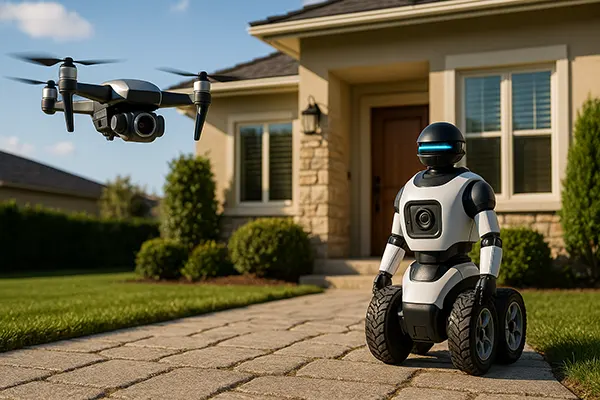
Integration of Drones and Robots into Private Home Security Systems: What’s Already Possible in 2025?
In 2025, home security is undergoing a technological transformation that blends robotics, artificial intelligence, and automation. Drones and autonomous robots are no longer futuristic concepts; they are now integral parts of advanced home surveillance systems. These technologies provide real-time monitoring, rapid response to threats, and unparalleled precision in detecting intrusions or emergencies, redefining what private protection means today.
The Role of Drones in Modern Home Security
Drones have evolved into intelligent, self-managing guardians of private properties. Equipped with thermal imaging cameras, facial recognition software, and GPS-based navigation, they can patrol perimeters autonomously. Unlike fixed cameras, drones offer flexible surveillance and can immediately react to movement or alarm triggers, sending live video feeds to the homeowner’s smartphone or control centre.
Many leading security firms now integrate drones with cloud-based monitoring systems. When motion sensors detect activity, drones are deployed automatically, scanning the area within seconds. These devices can track intruders discreetly, capture high-resolution images, and even communicate warnings through built-in speakers, adding a psychological deterrent effect.
Furthermore, drones with AI algorithms can distinguish between threats and harmless activity — such as pets or wind movement. This reduces false alarms and improves operational efficiency. Integration with smart home assistants allows users to control or schedule drone patrols using simple voice commands, demonstrating how consumer technology and professional-grade security have merged seamlessly.
Practical Implementations and Current Limitations
In several countries, companies like Sunflower Labs, Ring, and DJI have already introduced drone-based home surveillance systems available for purchase. These models automatically launch, patrol, and return to a charging hub without user intervention. Some premium versions can integrate with local police networks or private security services, allowing coordinated responses to verified threats.
However, there are still challenges to overcome. Legal frameworks around drone use — particularly concerning privacy, flight zones, and data storage — remain complex. Weather conditions also affect performance, as heavy rain or strong wind can restrict operations. Despite this, most modern drones are now designed with advanced stabilisation systems and waterproof casings, making them increasingly reliable year-round.
Energy efficiency is another key focus. Manufacturers are working on extended battery life and solar-powered charging hubs, which could allow for 24/7 autonomous operation. By 2025, such systems are becoming more affordable, paving the way for widespread adoption among private homeowners who prioritise intelligent and proactive security measures.
Robots in Home Surveillance and Response
Ground-based security robots complement drones by providing continuous on-site presence and physical interaction capabilities. These robotic guards patrol predefined routes, record 360-degree video, and detect anomalies using motion and sound sensors. When integrated with smart locks, they can even secure doors or activate alarms autonomously.
Companies like Knightscope and SMP Robotics lead this segment, offering mobile security units that combine LiDAR navigation with AI-powered recognition systems. These robots are particularly useful for large estates or gated communities where continuous movement and on-ground verification are essential.
Beyond surveillance, robots also support emergency management. For instance, in case of fire or gas leaks, they can assess danger zones before human responders arrive. This integration between robotics and smart home systems significantly enhances both safety and operational efficiency.
Interaction Between Humans, Robots, and AI
The success of robot integration relies on the harmony between human operators and artificial intelligence. Users can set patrol schedules, define no-go zones, and monitor real-time footage through mobile apps. AI continuously learns from daily operations, improving pathfinding accuracy and recognising new behavioural patterns in the monitored environment.
Voice-controlled interfaces and AR dashboards are now standard features, allowing homeowners to issue commands or review surveillance data conveniently. For example, a simple voice prompt such as “check the backyard” can activate a patrol robot to investigate a specific area, streaming footage directly to a user’s device.
In addition, robots can collaborate with drones, exchanging information in real-time. When a drone detects movement from above, it can alert a ground robot to verify the situation. This synergy ensures layered protection — aerial detection combined with on-site confirmation — reducing both response time and potential blind spots.

Integration, Connectivity, and the Future of Smart Security
Modern home security systems depend heavily on seamless integration between devices, networks, and data platforms. In 2025, most drones and robots operate under unified ecosystems managed via cloud-based AI control hubs. These hubs allow users to customise responses, manage recorded footage, and integrate with other smart devices such as lighting, alarms, and door systems.
Interconnectivity also extends to external networks. Some homeowners opt to link their systems with private security companies for instant alerts and emergency deployment. Encrypted communication ensures that sensitive information remains secure, preventing unauthorised access or data interception.
Looking ahead, the convergence of robotics, AI, and renewable energy promises fully autonomous security systems. Within the next decade, experts expect self-sustaining networks capable of learning, adapting, and communicating across smart city infrastructures. The home of the future will not only be secure but also intelligent — capable of predicting and preventing risks before they occur.
Ethical and Social Implications
As automation becomes deeply embedded in private life, ethical considerations are crucial. Transparency about data usage and strict compliance with privacy laws are essential to maintaining public trust. Manufacturers must ensure that AI systems operate responsibly and that users understand how their personal data is handled.
Public perception is gradually shifting. While some remain cautious about surveillance technologies, the benefits of enhanced safety and rapid incident response are undeniable. By maintaining ethical standards, manufacturers and policymakers can ensure that innovation serves society without compromising individual rights.
Ultimately, the integration of drones and robots into private home security represents a defining moment for personal protection. In 2025, these technologies already demonstrate that safety, efficiency, and automation can coexist — making homes smarter, safer, and more self-reliant than ever before.
